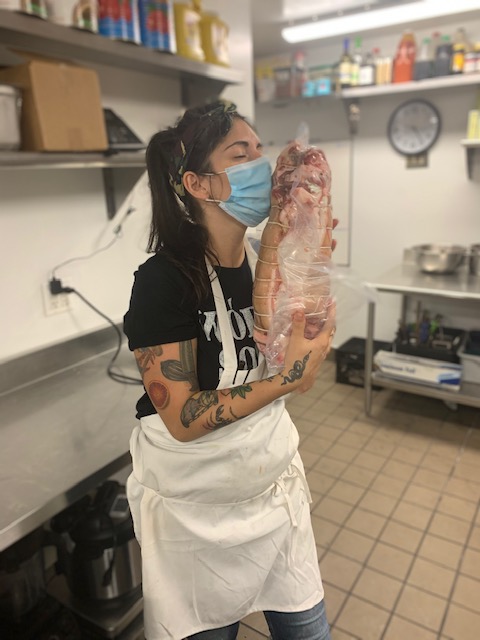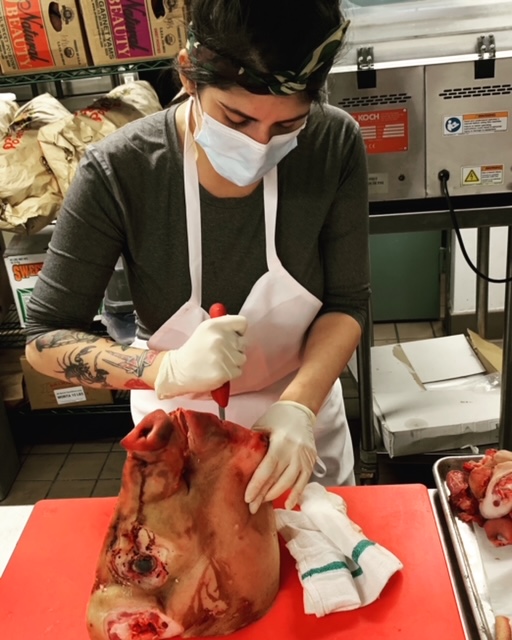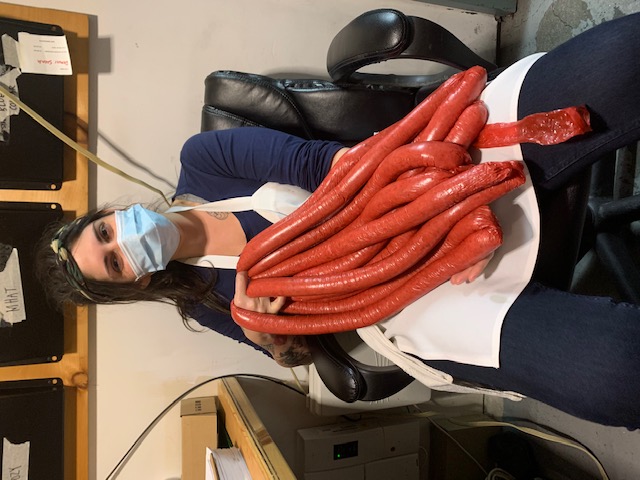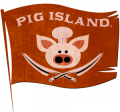Kimberly Plafke grew up on a steady diet of chicken fingers and buttered noodles but now waxes poetically about all the ways to cook a pig’s head. This badass butcher went from picky eater to executive chef and is now the production manager at The Meat Hook in Brooklyn where she works with whole animals and utilizes off cuts and scraps to make sausages and other prepared dishes. You can visit The Meat Hook or order for pickup or delivery to try some of Kimberly’s creations. As told to Sarah Strong. This interview has been edited and condensed for clarity.

Food Karma: How did you get into butchery to start with?
Kimberly Plafke: My family was really big on cooking growing up, but I was the pickiest eater of all time: it was like buttered noodles and grilled cheese sandwiches and chicken fingers until I was probably 20 years old, that’s how bad it was. I wanted to cook for a living, but said to myself, “Well, I don’t eat anything so iIm really going to have to try some food if I’m going to make it as a chef.”
I was a bartender at a fine dining Japanese restaurant in Florida so we had a lot of sushi and we had a lot of cool meat stuff there. I went to my boss and said, “the entire menu, right now.” He asked if I was kidding but I told him that I needed to try foods because I didn’t eat anything. I didn’t even like touching chicken unless it was deep fried and breaded and cooked and covered in hot sauce. He put literally one of everything in front of me, and I immediately thought, “Wow, I cannot believe I wasted twenty years not eating anything, this is all amazing.”
I really liked a lot of not just meat butchering, but watching the sushi chefs there cut all the fish and then cut all the wagyu and doing all this cool stuff. I always liked watching them and then when I ate it I realized it was incredible, so that’s kind of when my brain started putting together that I really like this meat and this fish and I really like watching these guys cut this stuff because it’s beautiful and elegant – that’s what I want to do, that’s the kind of food I want to do.
I come from a very traditional, Jewish family, and there were always briskets and meats around. Both my parents do everything from scratch, so I also liked watching them, but that was the moment at this restaurant when I was 19 or 20 when I decided I definitely want to do butchering. It’s delicious, and watching these men do this is like watching an elegant knife ballet.
FK: Why did you want to cook in the first place if you didn’t like to eat?
KP: What my mom tells me is that I would always cook for my family and friends, I just never really ate anything that I made. I really liked the act of cooking: it was fun and therapeutic and I liked the heat from the kitchen. I liked the action itself, I just never really ate anything. I honestly can’t remember a time in my life, even when I was a young child, when I wasn’t helping my parents cook.
FK: How did you make the jump?
KP: I saved up some money for a couple years and moved to New York when I was 22 or 23. I walked right into what was known at the time as the French Culinary Institute in SoHo and gave them all my money that I had saved and enrolled in school there. It was a nine month course and you had to do some butchering. I remember helping the school butcher a lamb. I had been cooking my whole life, so I had pretty decent knife skills for someone who hadn’t really eaten a lot of foods until she was an adult. I remember her telling me I had a natural talent for cutting meat. I was glad she said that because that’s what I wanted to do. So I helped her make sausage and kind of just took off from there
Since then, I’ve been working in kitchens in New York for twelve years. I’ve gone back and forth between whole animal meat and extremely sustainable seafood and shellfish, but I always am the one to cut the meat or cut the fish or do the knife work. I just really like that aspect of cooking a lot.

FK: Have you mostly been at butchers or restaurants?
KP: Right now, I am at The Meat Hook, but up until starting here I was actually an executive chef for a little over half of a decade. I was most recently before this at Grand Army Bar in Brooklyn which is a really well known cocktail place.
FK: Do you miss one when you’re doing the other?
KP: It’s always like the grass is greener. Being at The Meat Hook is so different from running a restaurant. First of all, I work mornings now, which I have never really had to do. That was the huge change. Because I work mornings, I have the rest of the day. I can have a personal life and I get to be more active and actually see the sunlight when I leave work.
The position that I have at The Meat Hook is really, really unique and niche. My title is the production manager. I was able to bring the executive chef experience to that, plus I have worked in whole animal restaurants before, so I’m pretty familiar with cutting meat and making sausage. But I also can think about the product and what it’s really going to look like on someone’s plate rather than just thinking about how the sausage will taste on its own.
I do some butchering, but we have a whole team of really awesome, talented butchers that are just dedicated to cutting the meat for the case. I get to do this whole other thing of the meat fabrication. Sometimes I butcher parts of the animal or the whole animal, but I get to take all these little bits, all these little odds and ends, and turn them into something else. I do the charcuterie and the sausages and ready to eat goods like beef bourguignon that people can buy in a quart container. I also do things like roast all the bones and pick all the little bits of chicken meat off the bones to make a smoked chicken salad that someone can just come in. Being a chef in the past, I get to bring those recipes and those ideas so that we really never waste anything. We utilize 100% of the whole animal, which is incredible. There’s almost no waste whatsoever
My position there is really awesome. Obviously I do miss restaurants, but I get to use all the skills that I learned as a line cook, a sous chef and an executive chef, both food skills and the administrative side of things that I was doing as a chef, and put that towards this already incredible meat fabrication program that The Meat Hook has. It’s really, really fun and very fulfilling. It’s probably the most fulfilling job that I’ve ever had.

FK: How long have you worked at The Meat Hook?
KP: I’ve only been there since July of last year. During the pandemic when the world ended I pivoted from restaurants to this, and it was the best decision that I’ve ever made.
FK: what are some good introductory off cuts for people who want to support whole animal butchery?
KP: Obviously the pandemic has been the worst thing to ever happen, but what I have noticed is that so many more people are now not going to restaurants so they have been buying more. The Meat Hook is slammed every day with lines two blocks down the street, it’s nuts. People will often buy the more popular cuts first – with pigs they’re buying pork chops or ribs or pork loins and with beef they’re buying ribeyes and porterhouses and short ribs. We only order whole animals, we don’t order pieces, so once they’re sold we don’t have any more of those cuts until the next whole animal delivery which might not be until the next week.
So people are wanting to know what else is good in a cow and what else is good in a pig. Honestly, the pig head is so delicious, and we have eight giant pig heads a week. You can cut the cheek off, it’s called the jowl, and you can make bacon out of it, you can braise it, you can fry it up, it’s awesome. You can use it to make my favorite charcuterie of all time: porchetta de testa. You take all the bones out of the head, you take the brains out, you take the eyes out and you season it. The skin and jowls and cheeks are still on and the tongue is still attached. I season it with orange zest, salt, pepper, herbs and spices then roll it really tightly and poach it overnight. You put it in some water in the oven for twelve hours, take it out the next day and chill it. It’s the best sandwich meat you’ll ever have.
Getting to talk to people about a weird cut of pork that comes from its face is a very fun thing, and people are into it. People think, “2020 and 2021 have been the wildest years ever, why not eat some pig heads?”
With cuts of beef, there’s other steak if you’re really craving a steak. There’s a steak called the Denver cut from the chuck area, the upper part of the cow, and it’s so tender and so marbled. It’s so affordable because not many people know what it is. It’s honestly to me more tender than a filet mignon and more marbled than a strip steak. It’s so awesome, and now other people are getting to try these things and getting familiar with these off cuts.
You can eat the entire animal. You can make stock from the bones. With a pig, you could cook the trotters, you could smoke the hocks and do pulled pork with them. You can pretty much do anything with any part of the animal. Everyone at The Meat Hook, including myself, can recommend great cuts which is awesome.
There’s always an alternative. People will get disappointed. With short ribs for example, if we’re out of short ribs and they tell us what they wanted to make we can say that two inches away from the short rib is something called the navel. It’s almost exactly the same in terms of how you can cook it and how it looks, but it’s creamier and richer and to me even better. They’ll be a little skeptical but they’ll buy it because they need something. Then the next time they come back they say short ribs are a thing of the past. It’s really cool that people might be a little skeptical and then when they come back they tell us that was the best thing ever. It’s really rewarding to hear that people are receptive and open to it.

FK: Is it harder to convince people to try these cuts on restaurant menus?
KP: Both in restaurants and at the butcher shop, it’s not just about what you call the cut, it’s also about the staff you have. If you train your staff really well and they can explain things or at a restaurant a server or a bartender can explain, yeah this might be a little strange, but it’s going to taste like this and it’s going to be rich and fatty and unctuous, if they make it sound good and they can explain it correctly, then people are usually into it. With a composed dish in a restaurant, all the other things matter too, and a guest can read it as a whole and get really into it.
I was the senior sous chef at The Cannibal many years ago, they’re unfortunately no longer open, but we would get whole pigs in and we kind of just sometimes wouldn’t tell people what they were getting. People would do a whole animal tasting, and we would just make it however we wanted, and they would eat it. Sometimes the more they know the more receptive they’ll be and sometimes the less they know the more receptive they’ll be. It comes with the experience, seeing what you can do and what people will eat, but usually once they have something if it tastes good they’re going to get it again no matter what it is. You can tell someone it’s fried brains after they eat it. They don’t know what it is, it looks like a chicken nugget when we’ve deep fried a brain. When you tell them they’ll eat it again if they liked it.
FK: It’s cliche to ask the question about being a female chef, but there’s definitely less visibility for female butchers. Do you have a network of women in the field you can talk to about it?
KP: I feel all the things when you ask me that question. On the one hand it irks me to be called a female chef or a female butcher. I’m just a chef and a butcher. There’s no difference. I’m equally experienced and even more experienced than my male counterparts.
So on the one hand, it irks me, but on the other hand, I want to empower other women and other female chefs. It’s such an emotional question, but yes, I do, to answer your question. I’m very lucky that New York has so many women chefs and women butchers. At The Meat Hook specifically, our director of operations who was a butcher at the shop for a long time, our “culture queen” who does all of our pr and stuff like and was a butcher there, our longest butcher who has been there for seven years, our brand new butcher we just hired and I are all women. We have some men there too, and the owners are men, but there are so many all over. Angie Mar is a big meat chef and everyone knows her, Cara Nicoletti has her own sausage company, there are a lot of women that have made their bones in New York.
Outside of New York, I’m sure there’s the same amount of women doing these positions, but they’re not getting any recognition. It’s so dumb. New York is kind of where you have to be to be able to be on an equal playing field, and it’s not even an equal playing field still to be totally honest. Luckily I do have many friends. Many of the cooks at the cannibal were women. As a chef, I hire the best people. If you’re the best line cook, I’m going to hire you, and 50% of the time that’s women. I happen to have a close relationship with a lot of women in the meat heavy side of the food industry and just the chef side of the industry.
I’m from Florida, and parts of Florida are great, but there’s a reason Florida is the butt of the joke in this country. They empower women to do a good job in the way any boss is going to empower their employees to do a good job, but it’s still this deep patriarchal idea ingrained in everybody’s brain that the men do the heavy lifting and the women do the other stuff.
It’s so silly. The women at The Meat Hook can lift more and cut more than any of the guys there, so i hope it changes. It is definitely slowly changing that way ,but too slow in my opinion. Up until very recently, I have pretty much sacrificed an entire personal life. I’ve had to work way more hours than any other male chefs that I know. I’ve had to go 200% just to show that I’m just as good as a man going 100%. If that’s how it’s been for me in very progressive New York, I’m sure elsewhere it is way worse, way harder, way more difficult for an owner to get behind the crazy idea of a woman doing stuff that’s cool. It drives me nuts.

FK: Is there anything we should be looking out for from you at The Meat Hook?
KP: I haven’t worked a full summer there yet, but hopefully as more people get vaccinated we can do some cool things. We have a pretty large backyard area behind the shop. During the winter, I was doing my own little barbecue program out of it where I was taking all these cuts that don’t sell, as well things like pork hocks or the beef navel, and I was fabricating them into barbecue items. We would sell them by the pound outside of our gigantic smoker. People would line up to buy barbecue, but it would be great if we could have backyard barbecues and grill burgers.
I’m looking forward to implementing more community type stuff and group things, which obviously are all on hold until the world stops being the way that it is right now. I want to do some cool collaborations since I do have a lot of connections in the chef world and bring some of these chefs that I know that do great work but buy meat in pieces so that those chefs will see the benefit of using off cuts in their restaurants and hopefully start to focus more on utilization of whole animals or weird things so that anybody eventually gets to the same ethos that The Meat Hook has of sustainable meat and soil regeneration and moves away from the factory farmed meats. I really want to implement some stuff like that so we can educate in a fun way, in a party way where we’re cooking together with other people in the food community that aren’t in the butchering community so they can see how we do things and maybe adapt to that sort of mindset as well.
What I really want is for people to think about meat the same way that we do at The Meat Hook that you can use everything. Every part of it is good. And the other thing is, half of what you’re eating is being made by women. I’m trying to show people that
